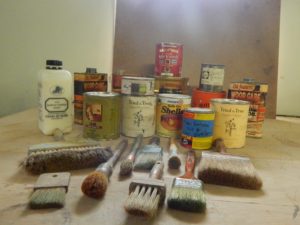Wood Finishing
A job begun well doesn’t end well if it isn’t finished well
A good finish on wood begins with good prep. work. But it doesn’t end there. A lot of factors go into determining the proper clear finish for any given architectural element.
Consideration of the historical relevance of a particular clear finish is at the top of the list of issues to be addressed. There are few historic and vintage contexts in which polyurethane is a good idea. All but the most expensive, European polyurethane products have a plastic appearance to them that is incompatible with the finishes that would have been applied a hundred years ago. While not everyone wants to be so historically accurate as to reproduce the original shellac finish that was the stock-and-trade in vintage homes, there are contemporary alternatives that produce a similar feel and appearance.
Selection of sheen is another decision that should be made intelligently. The easiest option–hence the one most often chosen–is to choose a satin finish which, because of its opacity, covers over a multitude of sins. But there are a lot of instances in which this choice deadens the wood.
Saturation of the finish is another factor. The difference between a mediocre job and a professional finish has a lot to do with achieving the proper degree of saturation of any given finish, which translates into the number of coats of finish that are applied.
At Oak Brothers, we put as much thought into choosing our finishing material as we do any other part of the project. A whole range of options are available to us, from our extremely reliable, shellac-simulating varnish to a wide range of historically accurate finishing materials–shellac, tung oil, waxes, linseed oil, and similar materials.

